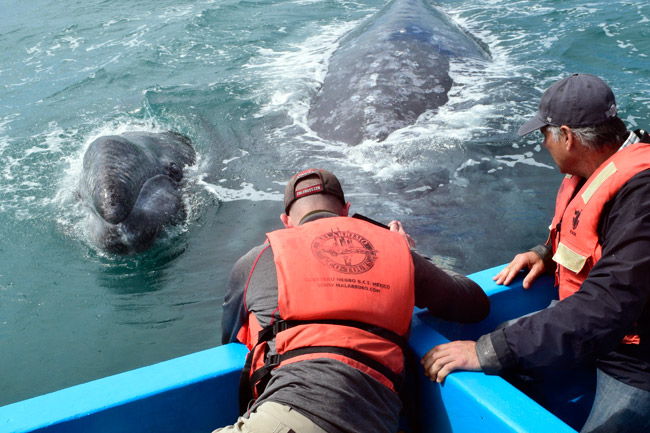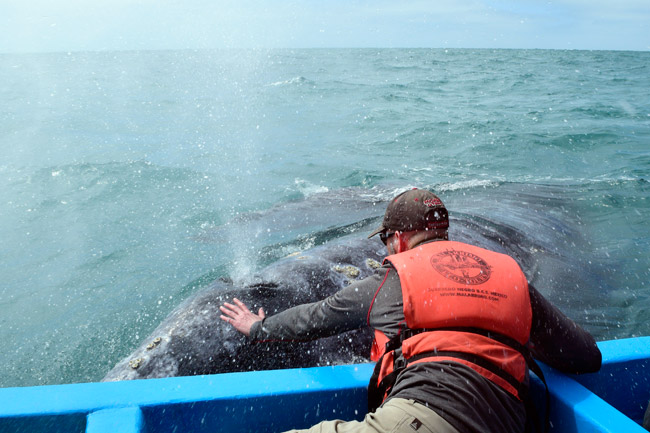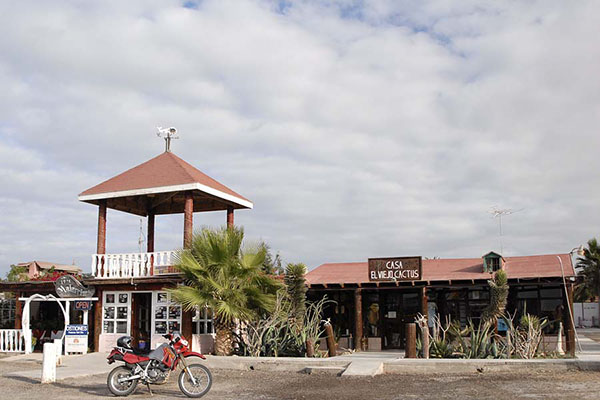The very title conjures excitement. Whales! Big, giant monsters…the creatures of legend. Visions of Moby Dick. Herman Melville. Call me Ishmael, and all that…
Yep, this is a topic I’ve covered before, back in September, but I like whale watching in Baja so much I thought we’d cover it again. And yeah, Danny boy, you’re right…we’re inviting you to ride with us in March if you want to go. You have to pass the personality test (which basically means if you’re a jerk we’ll take a pass) and you’ll have to convince us you have a significant social media presence (we want you to help us spread the ExNotes word). Oh, yeah…one more thing…you’ll have to show up with a copy of Moto Baja! We’ll sign it for you, and we want you to read the book so you know a bit more about riding in Baja before we head out. We’ll be putting out more details on our March Baja ride in the near future, so keep an eye on the blog.

I’m convinced that the only reason the towns of Guerrero Negro and San Ignacio are not absolutely overrun with visitors during the months of January through March is that most folks just don’t know about the whale watching in Baja. To get to the point: It is the best in the world. That’s no idle overreach or hyperbole on my part. It is the best. It is the only place on the planet where you can get up close to the California grays and, in many cases, actually touch them. Go whale watching here in California and there will be maybe a hundred or more people on a large boat, and the closest you’ll get to a whale is maybe a hundred yards out in the open ocean. You might see one or more spout in the distance and it’s “mission accomplished.”
Not in Baja. It’s way better in Baja. You’ll get on a little boat carrying maybe 8 or 10 people, you’ll go out in Scammon’s Lagoon or San Ignacio Lagoon, and you’ll be in the middle of a pod of whales. Up close and personal. One will spout, then another, and then, suddenly, it’s like being caught in a lawn when the sprinklers go off. You’re surrounded, and they’re all close.

That’s when the fun starts. A whale or two, maybe twice the length of the little boat you’re bobbing around in, come right up to your boat. As in touching your boat. Then they exhale, or spout, and you’re covered in what you hope is sea water and not whale snot. Everybody laughs, including the whales. You realize there are literally thousands of whales in your lagoon. And then you see two whales, and you realize the larger one is the mom. She’s literally pushing the little one closer to your boat, training her calf not to be afraid of people.

You’re excited about seeing the whales. They’re excited about seeing the people. That’s when you feel it. There’s some kind of extra-sensory-perception thing happening between you and the whales. No one who ever does this goes away feeling the same. I’ve done it maybe 20 times now, and I can’t wait to get down there to do it again.
The story goes like this: More than a century ago, whalers wondered where the whales were going. You see, the California grays spend their lives on the longest migration of any mammal. They winter in Baja and summer in Alaska (which probably makes them smarter than us). But when the whalers were hunting them, the bad guys didn’t know this. They harvested (read: slaughtered) the whales they could catch out in the open ocean heading south in the months before that January-March window, or headed north after those three months, always wondering where they were headed. Then, in the 1800s, a whaling captain named Scammon discovered the lagoon that carries his name today and the word got out: These whales are all holed up in Scammon’s Lagoon. It was a blood bath and the herd of approximately 20,000 California gray whales nearly went extinct.
That’s when the Mexican government stepped in and protected the herd. It’s taken a while, but they’re back up to a population of 20,000 whales, which is what the ocean will support.
A few years ago when I was on one of my whale-watching Baja trips, there were half a dozen Mexican Navy gun boats out in the lagoon, something I had never seen before. I asked our boat captain about it, and he told me that none other than Vincente Fox, President of Mexico, was going whale watching that day. He had plans to develop the Guerrero Negro area into an industrial center, a home for manufacturers, a move opposed by Mexican environmentalists because they feared it might affect the whales, the ospreys, the sea lions, and the other protected critters in this corridor. They implored Mr. Fox to see the whales, knowing that ESP thing would kick in. The day I was there he was doing that. After his excursion, folks asked the President if he would pursue his vision of an industrial zone. “Leave it as is,” Mr. Fox answered. He knew.
Getting there takes a day or two, and taking two days is the better approach. Simply head south from California. Cross in Tijuana, stop to pick up a free Tourist Visa, and head south. I’ve made Guerrero Negro in a single day, but that required getting up at 4:00 a.m. here in Los Angeles and riding hard for the next 700 miles, much of it in the Valle de los Cirios twisties. No, it’s better to take an easy lope down, spend the evening in San Quintin, El Rosario, or Catavina, and then continue the trek south the next morning. Hotels abound in all locations, and the ride south is best savored like a fine wine. Make sure you have Mexican insurance (go with BajaBound; we always do), and bring your passport. You won’t need it to get into Mexico, but you will need it to get back into the US.
The options are to stay in Guerrero Negro and grab a whale watching tour there, or continue south for another 70 miles to San Ignacio. In my opinion, Guerrero Negro is the better option because the ride to the Scammon’s Lagoon takes only a few minutes. If you stay in San Ignacio (a beautiful little town in the center of the peninsula) getting to San Ignacio Lagoon is an hour ride on a rough dirt (read: soft sand) road.

There are hotel choices in both places. I like Malarrimo’s in Guerrero Negro, but they’re all good. Malarimmo’s is the original place for Baja whale watching, but there are others and they are all good. You may be able to call ahead and get reservations, but it helps if you speak Spanish. If it just me and one or two of my friends, we just go. If I’m bringing a group down, I call ahead for reservations.
The whale watching tours are $50 (that’s US dollars), but trust me on this: It’s the best $50 you’ll ever spend.
You can go out in the morning or the afternoon (I usually pick the morning tour), and like I said above, the whales are in town from January through March. I like March, because the weather is milder, and I think the whales are friendlier (they’ve had three months to get used to interacting with people). You’ll see whales, you’ll see baby whales, and you might even get to see whales mating. Actually, if that’s going on, all you’ll see is a lot of turbulence on the surface, but they tell me there’s a whole lotta shakin’ goin’ on down there.
Whale watching in Baja: It’s a hoot…and it’s still one of the best-kept secrets on the planet. You need to get down there and see it before the rest of the world finds out. You can thank me later.

I can’t wait to do this, after a few times I’ve been in Baja, I’ve never went during Jan to Mar. For the 1st time if God permits I’m trying to be there this March 2019. I hope I have the chance to do this wonderful adventure. Thanks for all the info & sharing.